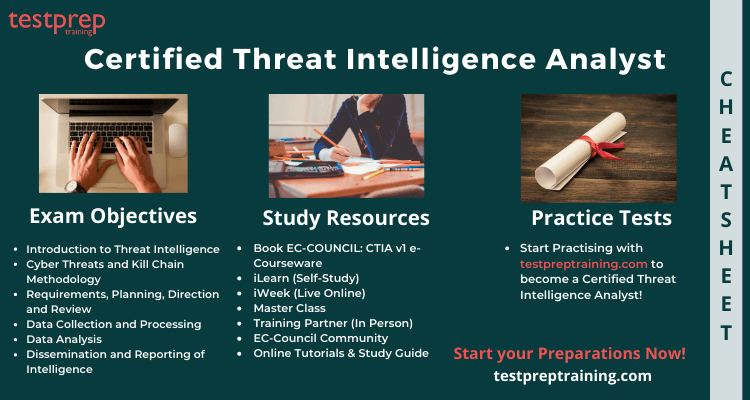The Certified Threat Intelligence Analyst (CTIA) Cheat Sheet is created to provide you with a bird’s eye view of the important exam section that one needs to know to qualify. Moreover, it is your information goldmine with all the right tools and resources to crack the exam. Before everything else, let’s have a quick glance at the exam details
Certified Threat Intelligence Analyst: Overview
The EC-Council Certified Threat Intelligence Analyst (CTIA) exam is a specialist-level training and certification that teaches security professionals how to acquire threat intelligence in an organized manner. EC-Council established this training and credentialing program. Additionally, this course provides professionals with standards-based, practical intense skills that are crucial in threat intelligence throughout information security. It entails gathering trustworthy data from a variety of sources, analyzing the data, producing valuable intelligence, and finally disseminating the resulting information to the appropriate stakeholders. As a result, organizations strive to improve their defenses and develop countermeasures by gathering intelligence about prospective attackers’ tactics, techniques, and procedures (TTP).
Who should take the exam?
The Certified Threat Intelligence Analyst Exam is designed to upskill-
- To begin with, Ethical Hackers
- Moreover, SOC Professionals
- Also, Threat Intelligence Analysts, Specialists
- Further, Digital Forensic and Malware Analysts
- Additionally, Incident Response Team Members
- Then, Threat Hunters
- Finally, Individuals from the field of security who aim to enrich their skills and knowledge in the field of cyber threats.
Certified Threat Intelligence Analyst Exam Objectives:
You must be clear on the exam objectives before you begin your preparations. Before taking the exam, it’s critical to go over each objective again. The Certified Intelligence Threat Analyst program and certificate are designed to help you achieve the following goals in a professional manner:
- Firstly, to enable organisations with the ability to prepare and run threat intelligence programme that provides effective advice about the existing unknown threats.
- Secondly, to ensure the presence of predictive capabilities as well as proactive measures in the organisation
- Also, to provide individuals with the techniques of data analysis including Statistical Data Analysis, Structured Data analysis and Competing Hypotheses
- Then, to provide a platform to share operational, tactical, strategic and technical intelligence.
- Lastly, providing knowledge for creating effective threat intelligence report.
CTIA Exam Eligibility:
To become eligible for the exam you must either-
- Firstly, Attend the official EC-Council C|TIA training through an accredited EC-Council Partner like iWeek, or iLearn. Further, on successful completion of this training programme you become eligible for the Certified Threat Intelligence Analyst Exam.
- Secondly, you need to submit an application showing a minimum of 2 years working experience in information security.
EC-Council Certified Threat Intelligence Analyst (CTIA) Cheat Sheet

For people who deal with risks on a daily basis, the CTIA test is required. As a result, exam modifications must be on par in order to succeed. To help you learn faster, we’ve created a step-by-step Cheat Sheet.
1. Review the Exam Objectives
The first step is to have a good understanding of the test and the CTIA certification review. You should have a good understanding of the modules and topics. For a more complete knowledge of the test, consult the official handbook accessible on the EC-Council website. Also, allot adequate time to each area so that you can master the test contents. The domains covered in this exam are:
– Introduction to Threat Intelligence
- Overview of Cyber Threat Intelligence (EC-Council Reference: Threat Intelligence in Cybersecurity)
- Understanding Threat Intelligence lifecycle and framework (EC-Council Reference: Step Process to Power your CYBER DEFENSE with CYBER THREAT INTELLIGENCE)
– Cyber Threats and Kill Chain Methodology
- Understanding cyber threats and advanced persistent threats (APTs) (EC-Council Reference: CYBER THREAT SCORES)
- Overview of Cyber Kill Chain and Indicators of Compromise (IOCs) (EC-Council Reference: The role of IOCS in Threat Intelligence Data Collection)
– Requirements, Planning, Direction and Review
- Understanding the Organization’s current threat landscape (EC-Council Reference: What you need to know about Cyber Threat Intelligence)
- Understanding Requirements Analysis
- Planning the Threat intelligence program (EC-Council Reference: Building Robust Cyber Threat Intelligence Program)
- Establishing Management Support
- Building a Threat Intelligence Team (EC-Council Reference: Threat Intelligence in Cybersecurity)
- Overview of Threat Intelligence Sharing (EC-Council Reference: Why Cyber Threat Intelligence Matters)
- Reviewing the Threat Intelligence Program (EC-Council Reference: Threat Intelligence in Cybersecurity)
– Data Collection and Processing
- Overview of Threat Intelligence Data Collection (EC-Council Reference: Cyber Threat Intelligence Data Collection and Acquisition)
- Overview of Threat Intelligence Collection Management
- Threat Intelligence Feeds and Sources (EC-Council Reference: Cyber threat intelligence feeds and sources)
- Understanding Threat Intelligence Data Collection and Acquisition (EC-Council Reference: Cyber Threat Intelligence Data Collection and Acquisition)
- Bulk Data Collection
- Understanding Data Processing and Exploitation
– Data Analysis
- Overview of Data Analysis
- Understanding Data Analysis Techniques (EC-Council Reference: Cyber Threat Intelligence Data Collection and Acquisition)
- Overview of Threat Analysis (EC-Council Reference: Cyber Threat Analysis Process and Components)
- Understanding Threat Analysis Process
- Overview of Fine-Tuning Threat Analysis
- Understanding Threat Intelligence Evaluation
- Creating Runbooks and Knowledge Base
- Overview of Threat Intelligence Tools
Use the EC-Council Certified Threat Intelligence Analyst (CTIA) Study Guide for better preparation!
– Dissemination and Reporting of Intelligence
- Overview of Threat Intelligence Reports
- Introduction to Dissemination
- Participating in Sharing Relationships
- Overview of Sharing Threat Intelligence (EC-Council Reference: Why Cyber Threat Intelligence Matters)
- Overview of Delivery Mechanisms
- Understanding Threat Intelligence Sharing Platforms
- Overview of Intelligence Sharing Acts and Regulations
- Overview of Threat Intelligence Integration
2. Quick Links to Study Resources
There are a variety of materials available to help you prepare for the exam. We hope you chose well because you have most likely been studying for this exam. However, here are some more tools that will help you speed up your modifications. These materials are intended to supplement your education. This include:
– Books to refer
When it comes to studying for a test, books have always been the ultimate best buddy. For information clarity and in-depth knowledge, make sure you consult real literature from credible sources. This is a pdf version of the EC-Council Certified Threat Intelligence Analyst book.
We suggest the official book by EC-COUNCIL: CTIA v1 e-Courseware that will definitely help you
– Training Courses
The training course is the most crucial aspect of your revisions. The EC-Council Certified Threat Intelligence Analyst (CTIA) training courses will provide you a comprehensive understanding of the test. For the Certified Threat Intelligence Analyst Exam, EC-Council offers its own training course. This three-day course will teach you all of the abilities you’ll need to pass our exam. It will also allow you to get hands-on experience and interact with subject matter experts in real-time. The training program is available in the following formats:
- Firstly, iLearn (Self-Study)
The iLearn curriculum is built on the self-study philosophy. To help with test preparation, EC-Council offers a streaming video version of its training course.
- Secondly, iWeek (Live Online)
The iWeek Program is an instructor-led, live, online training course that you may attend from anywhere. All you need is a reliable internet connection to get started.
- Thirdly, Master Class
You will have the opportunity to learn from world-class lecturers and leading information security experts as part of the Master Class program.
The Instruction Partner programme provides hands-on training. You may work together with your classmates and get practical experience.
3. Join the EC-Council Community
Your preparations must include participation in online forums and study groups. They encourage healthy debate and keep you informed about current events across the world. You’ll also get the chance to network with other students who are studying for the same test. Furthermore, such organizations may assist you in resolving any issues you may have while studying. It’s advisable that you join the EC-Council Community
4. Online Tutorials and Study Guide
Online Tutorials help you improve your knowledge and have a better comprehension of test themes. Furthermore, the EC-Council Certified Threat Intelligence Analyst (CTIA) Study Guides will be a valuable resource for you as you prepare for the test. These tools will assist you in remaining consistent and determined. They make learning more enjoyable.
5. Practice Tests for self evaluation
The last step is to double-check your work. This may be accomplished by taking practise exams. Such examinations will aid in the analysis of your hard work as well as the identification of your weaker areas. You will be more prepared if you work on them. Additionally, taking many practise exams can help you develop time management skills, which will be useful during the actual exam. Therefore, Attempt multiple practice tests and boost your confidence.



